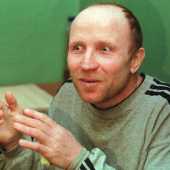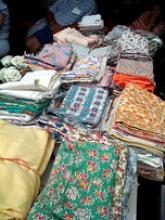Feedsack Cloth
Feedsack Cloth
I recently learned about "feed bag cloth," which is something that had been confusing me for years. I had heard stories along the lines of "we were so poor that my mama made all our dresses out of feed bags."
The only feed bags I've ever known are made of either brown paper (similar to "kraft paper" or butcher paper) or mylar plastic. I wrote this off as being one of those silly exaggerations people make sometimes.
That, or I imagined little kids going to school in big burlap sacks, like the bags that coffee is sold in. I pictured a hole being cut at the top for the head, and two holes on the sides for the arms. And the bottom left open, of course, for the little legs to stick out. Clearly that couldn't be a real thing.
Then I saw this post on the Mason-Dixon Knitting Blog, where Kay talked about a quilt made of feed sack cloth. And included a picture of the quilt. Which clearly was not either just a colorful exaggeration, or made of burlap sacks. In fact, it was pieced together out of pretty squares of printed cloth.
Imagine my confusion!
After doing some research, I learned that feed bags (and flour sacks, and a lot of other dry goods commodities) used to be sold in fabric bags. Manufacturers learned that women would use the cotton fabric for making quilts and clothing. (People were frugal back in the olden days. I don't see myself making a dress out of Doritos bags any time soon, except as an ironic commentary on consumerism and/or nutritional choices in modern-day America.)
The manufacturers began selling feedsacks which had printed designs on the inside, leaving the outside plain so that they could print their logo and selling information. This was usually printed in a water-soluble ink, so that the seamstress could simply wash away the company's name.
As soon as one company did this, their sales shot through the roof. It didn't take long before every other company followed suit. If you didn't have printed cloth on your bags, no one wanted it. You had to either position your cattle feed for the quilter's market, or you didn't sell any cattle feed.
Women collected feedsacks, and often held swap parties in order to trade for the right amounts of the patterns they needed. Many feedsacks were advertised as having just enough fabric to make a simple dress. Some sacks came with patterns included.
I don't know of any product today which has this benefit. Now I look sadly at my bags of Layena chicken feed and wish that I could use them for crafts! (Since they are made of recyclable paper, I use them to hold recyclables. It's particularly satisfying to take a Layena bag full of paper recycling, and chuck the whole thing into the paper recycling bin.)
You can still buy feedsack cloth online, although obviously supplies are limited. Some companies make a reproduction feedsack cloth, so be sure you're buying original stuff, if that is what you want!
The only feed bags I've ever known are made of either brown paper (similar to "kraft paper" or butcher paper) or mylar plastic. I wrote this off as being one of those silly exaggerations people make sometimes.
That, or I imagined little kids going to school in big burlap sacks, like the bags that coffee is sold in. I pictured a hole being cut at the top for the head, and two holes on the sides for the arms. And the bottom left open, of course, for the little legs to stick out. Clearly that couldn't be a real thing.
Then I saw this post on the Mason-Dixon Knitting Blog, where Kay talked about a quilt made of feed sack cloth. And included a picture of the quilt. Which clearly was not either just a colorful exaggeration, or made of burlap sacks. In fact, it was pieced together out of pretty squares of printed cloth.
Imagine my confusion!
After doing some research, I learned that feed bags (and flour sacks, and a lot of other dry goods commodities) used to be sold in fabric bags. Manufacturers learned that women would use the cotton fabric for making quilts and clothing. (People were frugal back in the olden days. I don't see myself making a dress out of Doritos bags any time soon, except as an ironic commentary on consumerism and/or nutritional choices in modern-day America.)
The manufacturers began selling feedsacks which had printed designs on the inside, leaving the outside plain so that they could print their logo and selling information. This was usually printed in a water-soluble ink, so that the seamstress could simply wash away the company's name.
As soon as one company did this, their sales shot through the roof. It didn't take long before every other company followed suit. If you didn't have printed cloth on your bags, no one wanted it. You had to either position your cattle feed for the quilter's market, or you didn't sell any cattle feed.
Women collected feedsacks, and often held swap parties in order to trade for the right amounts of the patterns they needed. Many feedsacks were advertised as having just enough fabric to make a simple dress. Some sacks came with patterns included.
I don't know of any product today which has this benefit. Now I look sadly at my bags of Layena chicken feed and wish that I could use them for crafts! (Since they are made of recyclable paper, I use them to hold recyclables. It's particularly satisfying to take a Layena bag full of paper recycling, and chuck the whole thing into the paper recycling bin.)
You can still buy feedsack cloth online, although obviously supplies are limited. Some companies make a reproduction feedsack cloth, so be sure you're buying original stuff, if that is what you want!


